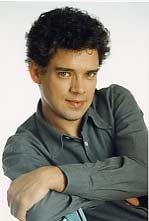S & H Concert Review
Wagner, Brahms, Sibelius; François-Frédéric Guy (pf), London Philharmonic Orchestra, Paavo Berglund, RFH, 31st May, 2003 (AR)
The name Paavo Berglund has become synonymous with the music of Jean Sibelius and he has had a long association with the Finnish Radio Symphony Orchestra and the Helsinki Philharmonic Orchestra in his native Finland.
With such a long experience and familiarity with Sibelius’ works, one would have expected the Sibelius Fifth Symphony to be the highlight of the evening, but this did not prove to be the case. Instead, this was provided by Brahms’ Piano Concerto No.2, and the inspired playing of François-Frédéric Guy.
The concert opened with a highly polished, if rather soulless, account of Richard Wagner’s Overture, Tannhauser. Berglund seemed to have reached the end of the overture as soon as he started: the opening passages were far too loud and strident, with the conductor building up the tension far too early – a sort of musical ejaculatio praecox - so that when we did get to the closing passages it was an anticlimax, with the trombones in particular sounding far too suppressed. A saving grace of this back-to-front performance was the superbly strident playing of the horns, and the strings had a shimmering sheen, displaying great rhythmic vitality.
Although Brahms’ Second Piano Concerto opened with a sadly sour-sounding horn solo, pianist François-Frédéric Guy offered us a wonderful blend of agile and assertive playing of the first movement. Guy displayed great virtuosity and dynamic range, floating his phrases with great eloquence and economy. Often this movement can sound heavy, but with Guy the drama came through due to his intellectual reserve. This movement was well paced by Berglund who coaxed the strings to play with great warmth and depth of feeling, but unfortunately it was marred by some very harsh horn intonation throughout.In the Allegro appassionato Guy played with an even deeper intensity, taking on darker colours and a greater sense of urgency. Again Berglund got some very expressive playing from the violins but gave little, if any, attention to the cello’s and double basses, who seemed barely audible and rather left to fend for themselves.
Guy played the Andante with a stark delicacy and ghostly detachment which was sadly often sabotaged by the solo cello, which seemed rather coarse. With the closing Allegro grazioso Guy switched to an extraordinarily subtle style of playing: sedate, reserved, light and buoyant. Indeed, so delicate was his playing that it was very often swamped by the LPO who played with great gusto. This was nevertheless one of the most insightful and sensitive readings I have heard of this concerto.
After this revelatory performance of the Brahms Second Piano Concerto, Sibelius’ Fifth Symphony, contrary to expectation, proved to be somewhat of a disappointment, despite Berglund’s affinity with the composer.
The opening Temp molto moderato was far too protracted, with the conductor completely losing the forward thrusting momentum and urgency this movement requires: one felt that the performance was in imminent danger of grinding to a halt. Despite Berglund’s mannered reading, he drew some shimmering, icy playing from the strings and impressive staccato blasts from the horns. The Andante mosso, quasi allegretto was perfectly paced, with Berglund making the music sound suitably menacing and brooding; again the horns took on an aptly rugged and stark quality; this was the most successfully rendered movement of an unevenly conducted symphony.
The Allegro molto was sadly a repeat of the first movement, with the conductor dragging the music out and losing any sense of tension and drive. In an early passage the double basses are required to play collegrio (with the back of the bow being tapped and dragged across the strings) creating a clattering sound. Unfortunately this was skimped by Berglund and consequently went for nothing. At the Barbican recently (17th April 2003) the National Youth Orchestra of Great Britain under Tortelier got this unnerving sound exactly right.
The conductor hauled the orchestra in his wake to the closing bars, becoming slower and slower until he came to the climactic, eternally-sounding blank spaces which were perfectly paced - and spaced - between blocks of sound; a perfectly measured ending to a rather eccentric and mannered reading. The other major flaw that marred this performance was the muffled sounding timpani. Although played very well, the timpani had very little impact. This hard-edged work really requires the use of hard sticks to provide the distinct, crisp definition so necessary to articulate it.
Alex Russell

 Return to:
Return to: